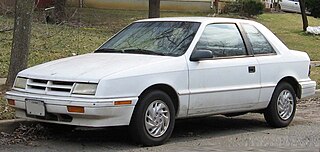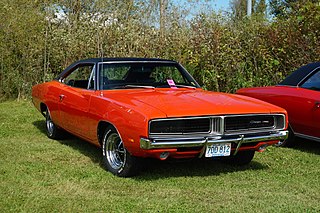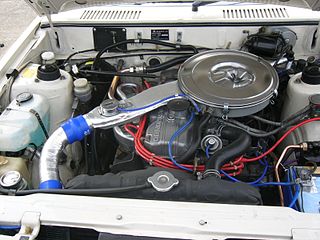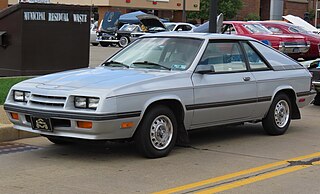
Carroll Hall Shelby was an American automotive designer, racing driver and entrepreneur. Shelby is best known for his involvement with the AC Cobra and Mustang for Ford Motor Company, which he modified during the late 1960s and early 2000s. He established Shelby American in 1962 to manufacture and market performance vehicles. His autobiography, The Carroll Shelby Story, was published in 1967.

The Eagle Talon is a sport compact hatchback coupé manufactured as part of a joint venture between Chrysler and Mitsubishi in two generations starting from the 1989 model year.

The Mitsubishi Eclipse is a sport compact car that was produced by Mitsubishi in four generations from 1989 until 2011. A convertible body style was added during the 1996 model year.

The Mitsubishi 3000GT is a front-engine, all-wheel/front-wheel drive grand touring/sports car manufactured and marketed by Mitsubishi from 1990 until 2000 over three different generations. Manufactured in a three-door hatchback coupé body style in Nagoya, Japan, the 2+2 four-seaters were marketed in the Japanese domestic market (JDM) as the GTO, and globally as 3000GT. In North America, it was sold both as the Mitsubishi 3000GT (1991–1999) and the Dodge Stealth (1991–1996), a badge engineered, mechanically identical captive import. As a collaborative effort between Chrysler and Mitsubishi Motors, Chrysler was responsible for the Stealth's exterior styling.

The Dodge Daytona is an automobile which was produced by the Chrysler Corporation under their Dodge division from 1984 until 1993. It was a front-wheel drive hatchback based on the Chrysler G platform, which was derived from the Chrysler K platform. The Chrysler Laser was an upscale rebadged version of the Daytona. The Daytona was restyled for 1987, and again for 1992. It replaced the Mitsubishi Galant-based Challenger, and slotted between the Charger and the Conquest. The Daytona was replaced by the 1995 Dodge Avenger, which was built by Mitsubishi Motors. The Daytona derives its name mainly from the Dodge Charger Daytona, which itself was named after the Daytona 500 race in Daytona Beach, Florida.

The Dodge Spirit is a midsize automobile marketed by Dodge from the 1989 to the 1995 model years. The singular successor of the Dodge Aries, Dodge Lancer, and the Dodge 600, the Spirit was slotted between the Shadow and the Dynasty within the Dodge product line. In contrast to its predecessors, the Spirit was sold exclusively as a four-door notchback sedan.

The Dodge Shadow and Plymouth Sundance are compact 3-door and 5-door hatchbacks that were introduced for the 1987 model year by the Chrysler Corporation. For 1991, a 2-door convertible variant was added to the Shadow lineup; this bodystyle was not offered by Plymouth. The Sundance/Shadow replaced the Omni/Horizon models of their respective marque.

The Dodge Lancer is an automobile that was marketed in three unrelated versions by Dodge during the 1950s, 1960s, and 1980s. The first version debuted as a hardtop version of the full-sized 1955 Dodge, and was produced in that form until 1959. The second version revived the nameplate in 1961 for a Chrysler A platform-based compact that was marketed for two model years and replaced by the Dodge Dart. The third version returned the Lancer nameplate in 1985 for a front-wheel drive mid-sized Chrysler H platform model that was in production until 1988 after which it was replaced by the Dodge Spirit.

The Dodge Charger is a model of automobile marketed by Dodge in various forms over eight generations since 1966.

The Dodge Omni and the nearly identical badge engineered variant, the Plymouth Horizon, is a subcompact car manufactured and marketed by Chrysler Corporation for model years 1978-1990. The first Chrysler model line produced with front-wheel drive, the Omni and Horizon were also the first front-wheel drive economy cars assembled in the United States. Marketed for eleven years with very few changes, around 2,500,000 Omnis and Horizons were manufactured, with the Plymouth variants more popular than the Dodge-branded models.

The 2.2 and 2.5 are a family of inline-4 engines developed by Chrysler Corporation originally for the Chrysler K- and L-platforms cars and subsequently used in many other Chrysler vehicles. After its launch in 1981, it became the basis for all Chrysler-developed 4-cylinder engines until the Chrysler 1.8, 2.0 & 2.4 engine family was released in 1994. It was the first Chrysler engineered four cylinder engine since the Chrysler flathead four cylinder was discontinued in 1933.

The Mitsubishi Starion is a two-door, turbocharged four-cylinder rear-wheel drive four-seat fastback sports car manufactured and marketed by Mitsubishi from 1982 until 1989 — with badge engineered variants marketed in North America as the Conquest, under the Chrysler, Dodge, and Plymouth brands.

The Shelby Mustang is a high-performance variant of the Ford Mustang built by Shelby American from 1965 to 1967 and by the Ford Motor Company from 1968 to 1970.

The Shelby GLH-S is a limited production series of sport compact automobiles from the mid-1980s based on the Dodge Omni and modified by Shelby American. Later the name would also be applied to a Shelby modified version of the Dodge Shelby Charger. The GLH-S models all used intercooled turbocharged 4-cylinder engines.

The Shelby Lancer is a limited-production hatchback sports sedan based on the Dodge Lancer. Modified by Shelby Automobiles in Whittier, California for 1987 and offered in Graphic Red only, the Shelby Lancer was intended to be an American counterpart to European sedans such as the BMW 3 Series and Peugeot 405. It featured many amenities not offered on the normal Lancer, including a special 10-speaker Pioneer CD audio system, one of the first Compact Disc systems offered in an American car. A total of 800 units were produced; 400 came with a 3-speed automatic transmission (A413) and leather interior, and 400 with a 5-speed manual transmission (A520) and cloth interior. Other Shelby-branded items included a numbered plaque attached to the dashboard along with Shelby 15 inch wheels, a Shelby steering wheel, and a Shelby valve cover. The various VIN plates and build labels on the car all indicated "Shelby Automobiles" instead of the typical Chrysler or Dodge labels found on normal production vehicles.

The Mitsubishi Astron or 4G5/4D5 engine, is a series of straight-four internal combustion engines first built by Mitsubishi Motors in 1972. Engine displacement ranged from 1.8 to 2.6 litres, making it one of the largest four-cylinder engines of its time.

The Mitsubishi Sirius or 4G6/4D6 engine is the name of one of Mitsubishi Motors' four series of inline-four automobile engines, along with Astron, Orion, and Saturn.

The Dodge Caliber is a compact hatchback manufactured and marketed by Chrysler's Dodge division from the 2007 through 2012 model years, replacing the Dodge Neon and Chrysler PT Cruiser.

The Dodge Charger (L-body) is a subcompact two-door hatchback/fastback built by Dodge from 1981 until 1987. It is based on Chrysler's front-wheel drive L platform. A companion model, the Plymouth Turismo, was also marketed.

Shelby American, Inc. is an American high performance automobile company founded by driver Carroll Shelby. The Shelby American name has been used by several legally distinct corporations founded by Shelby since his original shop in Venice, California began operation in 1962. The current iteration is a wholly owned subsidiary of Carroll Shelby International, Inc., a holding company formed in 2003. Carroll Shelby International's other wholly owned subsidiary is Carroll Shelby Licensing, which licenses the name and trademarks associated with Shelby to other companies. Shelby American was the first automobile manufacturer in the state of Nevada. Shelby American manufactures component automobiles, including replicas of the small-block and large-block AC Cobras, the Shelby GT350 and the GT500 Super Snake. Since 2005, Shelby American has released new models each year.
























